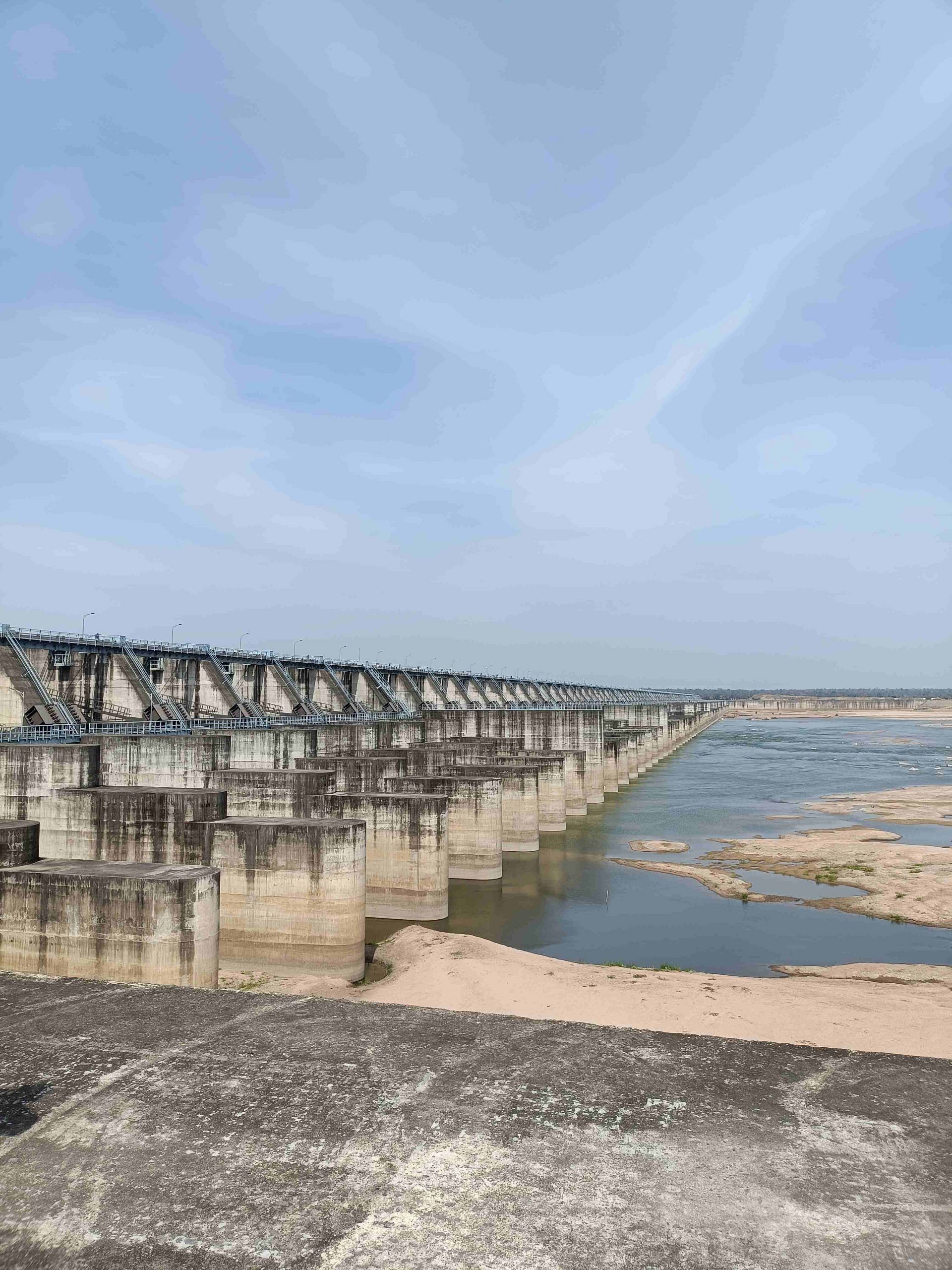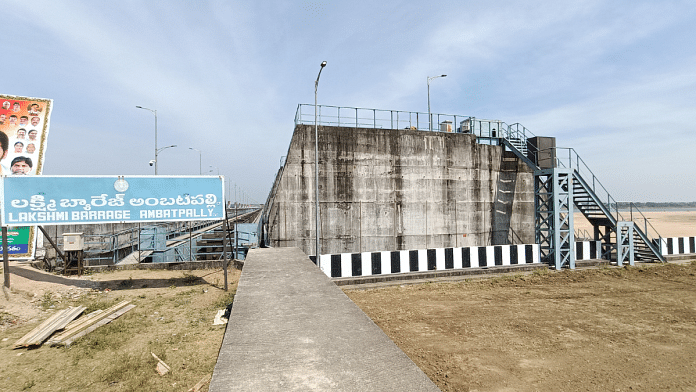Hyderabad: Slamming former Telangana Chief Minister K. Chandrashekar Rao’s showpiece Kaleshwaram lift irrigation project as “economically unviable”, a new report from the Comptroller and Auditor General (CAG) has said that every rupee spent on it would yield only 52 paise in return.
The report, tabled in the Telangana assembly Thursday, said the cost of the mammoth project is now likely to exceed Rs 1,47,427 crore, as against the cost of Rs 81,911 crore projected by the former government to the Central Water Commission.
The CAG report came as yet another indictment of KCR’s Bharat Rashtra Samithi (BRS) government, whose project has been a subject of much controversy. The Kaleshwaram Project is a multi-purpose and multi-stage lift irrigation project that seeks to lift water from the river Godavari at Medigadda and supply it across 13 districts of Telangana up to Hyderabad and adjoining areas.
In its report, the CAG performance audit report has further claimed administrative, and financial mismanagement in a project that KCR called “Telangana’s lifeline”. The report pertains to audits till March 2022, i.e., over a two-and-a-half-year period after the commissioning of the project.
“The Telangana government had not accorded administrative approval of the project as a whole and instead it has issued separate approvals i.e. as many as 73 administrative approvals aggregating to Rs 1,10,248 crore. There are no orders from the government about the project’s funding pattern,” the report said.
“The absence of a comprehensive plan duly spelling out the sources of funds for a project of this scale, which will have a long-term impact on the finances of the State, is an indication of improper planning,” it added.

The Kaleshwaram project, inaugurated by then chief minister KCR at Medigadda in June 2019 — in the first year of his second term — has been mired in controversies, with both now-ruling Congress and the opposition BJP claiming then that there were gross inadequacies, in addition to massive corruption, in the project execution.
Ahead of the crucial assembly polls last year, the Medigadda (Laxmi) barrage developed cracks and six piers in three blocks partly sank on 21 October. The incident prompted the opposition to target the KCR government again.
Soon after this, an expert team from the National Dam Safety Authority found planning, design, quality control, and operation-maintenance faults, which it said resulted in the sinking of the piers that rendered the barrage useless.
The 16 thousand million cubic feet (TMC) barrage was emptied for inspection, while the government mulled options for rehabilitation.
A Telangana vigilance and enforcement department report, commissioned after Revanth Reddy’s Congress government assumed power in December, also pointed out the previous BRS government’s time construction lapses as having caused the damages to the Rs 4,321 crore barrage — a major component of KLIP.
‘Overstating project benefits, understating the annual cost’
Divided into seven links and 56 packages, the Kaleshwaram Project comprises three barrages, (Medigadda, Sarawasti or Annaram, and Sundilla), 14 reservoirs, 31 lifts, and 1,832 km of canals, tunnels, and pipelines.
The project seeks to lift 215 thousand million cubic feet (TMC) of water from the Godavari to irrigate 18.26 lakh acres of new Command Area (CA) in 13 districts and to supplement water to an already existing CA of 4.71 lakh acres of four other existing projects where water availability is now falling short of the requirement.
Command area or ayacut is defined as the area that can be irrigated by a canal system.
According to the CAG report, out of the total expenditure of Rs 86,788 crore incurred on the project (March 2022), an expenditure of Rs 55,807 crore (i.e., 64.3 percent) was met from the off-budget borrowings raised by the Kaleshwaram Irrigation Project Corporation Limited (KIPCL), a Special Purpose Vehicle.
According to the report, the Benefit-Cost Ratio (BCR) of Kaleshwaram was inflated by overstating the project’s benefits and understating the annual costs. BCR is an indicator showing the relationship between the relative costs and benefits of a proposed project in monetary or qualitative terms.
“The agricultural benefits were calculated on the assumption that one TMC of water would irrigate 17,668 acres of ayacut. Data pertaining to other projects in Telangana show that one TMC of water can serve an average of only 10,000 acres. Thus, there is a significant risk that the 169 TMC of water allocated for irrigation under the project will not be sufficient for Kharif season and there is a high risk that no water will be left for irrigation in Rabi season,” it said.
Revenues from fisheries and from the supply of water to industries were also overstated, the CAG said.
“The annual recurring cost on electricity charges was understated by adopting a lower rate of Rs three/unit whereas the prevailing tariff for lift irrigation schemes was Rs 6.40/unit. Even with the understated project cost of Rs 81,911 crore, the BCR works out to 0.75 (as against 1.51 projected) indicating that the project was, ab initio, economically unviable,” it said.
Considering the latest likely project cost (₹1,47,427 crore), the BCR works out to 0.52, the report said. “This means that every rupee spent on the project would yield only 52 paise. The BCR is likely to go much lower considering the possibility of (a) further increase in the cost of works and interest during construction and the likelihood of the actual benefits/revenues from agriculture and industrial/drinking water supply being much lower than those projected by the irrigation department, (which executed the project),” the CAG said in its report.
The peak energy demand, when all the pumps are operated for lifting waters, is more than the average daily energy availed in the entire state (2021-22), the auditor said, adding providing power to lift irrigation schemes will pose a challenge to the state.
Against the targeted new Command Area (ayacut) of 18.26 lakh acres, the works entrusted so far (March 2022) included the development of a distributary network for only 14.83 lakh acres, the report said, adding that the actual command area created so far was 40,888 acres only (March 2022).
‘Undue benefit to contractors’
The auditor noted that the irrigation department had shown “undue haste” in awarding contracts for the project.
“Seventeen works costing Rs 25,050 crore were awarded even before approval of the Detailed Project Report (DPR). In the DPR, water for the project was proposed to be lifted from River Godavari at the rate of two TMC per day. The pumping capacity was later increased to three TMC per day involving an additional cost of Rs 28,151 crore,” CAG said.
The auditor also said that re-engineering and changes made by the KCR regime to the Pranahita Chevella Sujala Sravanthi Project — originally planned in the undivided Andhra Pradesh by then CM YS Rajasekhara Reddy — has turned certain portions of works already executed redundant, resulting in a loss of Rs 767.78 crore.
“Out of the 56 project works, only 12 works were completed, 40 works were ongoing while four works have not even commenced, as of March 2022. Lands required for distributary network, etc., are yet to be fully identified,” the report said.
The possibility of undue benefit of at least Rs 2,684 crore to the contractors for the supply and commissioning of equipment such as pumps and motors cannot be ruled out, the report said. It also said that the inclusion of price adjustment clauses after the tendering process was completed resulted in the avoidable payment of Rs 1,342 crore.
Significantly, both the BJP and the Congress have been claiming design flows and massive misappropriation of funds in the Kaleshwaram project.
Chief Minister Revanth Reddy led a delegation of Telangana MLAs to the Medigadda barrage Tuesday to inspect damages to its piers and pillars. The delegation comprised mainly Congress MLAs, but also a few All India Majlis-e-Ittehadul Muslimeen legislators and the CPI’s lone MLA in the state.
Both BJP and BRS skipped the tour. While Revanth wants a judicial probe on the entire Kaleshwaram fiasco, the BJP is favouring a probe by the Central Bureau of Investigation (CBI).
(Edited by Uttara Ramaswamy)



